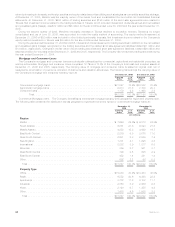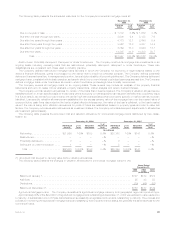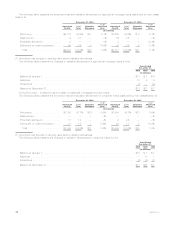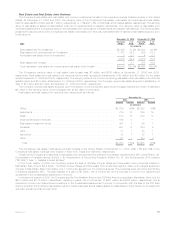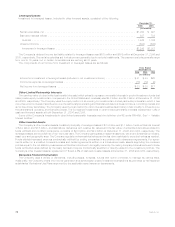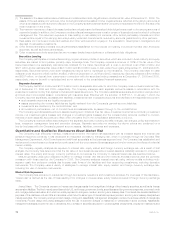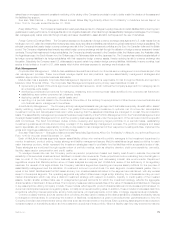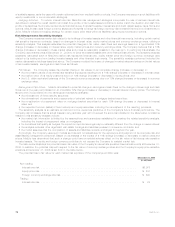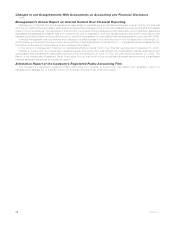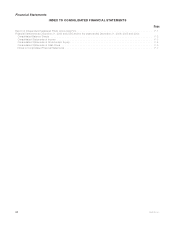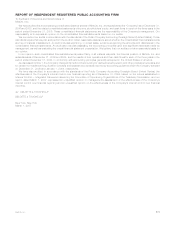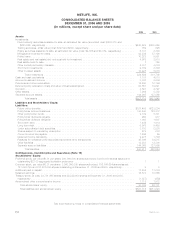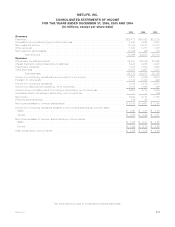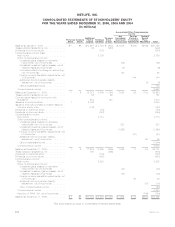MetLife 2006 Annual Report Download - page 79
Download and view the complete annual report
Please find page 79 of the 2006 MetLife annual report below. You can navigate through the pages in the report by either clicking on the pages listed below, or by using the keyword search tool below to find specific information within the annual report.
of available assets, as is the case with certain retirement and non-medical health products, the Company may support such liabilities with
equity investments or curve mismatch strategies.
Hedging Activities. To reduce interest rate risk, MetLife’s risk management strategies incorporate the use of various interest rate
derivatives to adjust the overall duration and cash flow profile of its invested asset portfolios to better match the duration and cash flow
profile of its liabilities. Such instruments include financial futures, financial forwards, interest rate and credit default swaps, caps, floors and
options. MetLife also uses foreign currency swaps and forwards to hedge its foreign currency denominated fixed income investments. In
2004, MetLife initiated a hedging strategy for certain equity price risks within its liabilities using equity futures and options.
Risk Measurement: Sensitivity Analysis
The Company measures market risk related to its holdings of invested assets and other financial instruments, including certain market
risk sensitive insurance contracts, based on changes in interest rates, equity market prices and currency exchange rates, utilizing a
sensitivity analysis. This analysis estimates the potential changes in fair value, cash flows and earnings based on a hypothetical 10%
change (increase or decrease) in interest rates, equity market prices and currency exchange rates. The Company believes that a 10%
change (increase or decrease) in these market rates and prices is reasonably possible in the near-term. In performing this analysis, the
Company used market rates at December 31, 2006 to re-price its invested assets and other financial instruments. The sensitivity analysis
separately calculated each of MetLife’s market risk exposures (interest rate, equity market price and foreign currency exchange rate)
related to its trading and non-trading invested assets and other financial instruments. The sensitivity analysis performed included the
market risk sensitive holdings described above. The Company modeled the impact of changes in market rates and prices on the fair values
of its invested assets, earnings and cash flows as follows:
Fair Values. The Company bases its potential change in fair valuesonanimmediatechange(increaseordecrease)in:
• the net present values of its interest rate sensitive exposures resulting from a 10% change (increase or decrease) in interest rates;
• the market value of its equity positions due to a 10% change (increase or decrease) in equity prices; and
• the U.S. dollar equivalent balances of the Company’s currency exposures due to a 10% change (increase or decrease) in currency
exchange rates.
Earnings and Cash Flows. MetLife calculates the potential change in earnings and cash flows on the change in its earnings and cash
flows over a one-year period based on an immediate 10% change (increase or decrease) in interest rates and equity prices. The following
factors were incorporated into the earnings and sensitivity analyses:
• the reinvestment of fixed maturity securities;
• the reinvestment of payments and prepayments of principal related to mortgage-backed securities;
• the re-estimation of prepayment rates on mortgage-backed securities for each 10% change (increase or decrease) in interest
rates; and
• the expected turnover (sales) of fixed maturity and equity securities, including the reinvestment of the resulting proceeds.
The sensitivity analysis is an estimate and should not be viewed as predictive of the Company’s future financial performance. The
Company cannot assure that its actual losses in any particular year will not exceed the amounts indicated in the table below. Limitations
related to this sensitivity analysis include:
• the market risk information is limited by the assumptions and parameters established in creating the related sensitivity analysis,
including the impact of prepayment rates on mortgages;
• for derivatives that qualify as hedges, the impact on reported earnings may be materially different from the change in market values;
• the analysis excludes other significant real estate holdings and liabilities pursuant to insurance contracts; and
• the model assumes that the composition of assets and liabilities remains unchanged throughout the year.
Accordingly, the Company uses such models as tools and not substitutes for the experience and judgment of its corporate risk and
asset/liability management personnel. Based on its analysis of the impact of a 10% change (increase or decrease) in market rates and
prices, MetLife has determined that such a change could have a material adverse effect on the fair value of its interest rate sensitive
invested assets. The equity and foreign currency portfolios do not expose the Company to material market risk.
The table below illustrates the potential loss in fair value of the Company’s interest rate sensitive financial instruments at December 31,
2006. In addition, the potential loss with respect to the fair value of currency exchange rates and the Company’s equity price sensitive
positions at December 31, 2006 is set forth in the table below.
The potential loss in fair value for each market risk exposure of the Company’s portfolio was:
December 31, 2006
(In millions)
Non-trading:
Interestraterisk............................................................ $5,975
Equitypricerisk............................................................ $ 241
Foreigncurrencyexchangeraterisk............................................... $ 690
Trading:
Interestraterisk............................................................ $ 25
76 MetLife, Inc.




